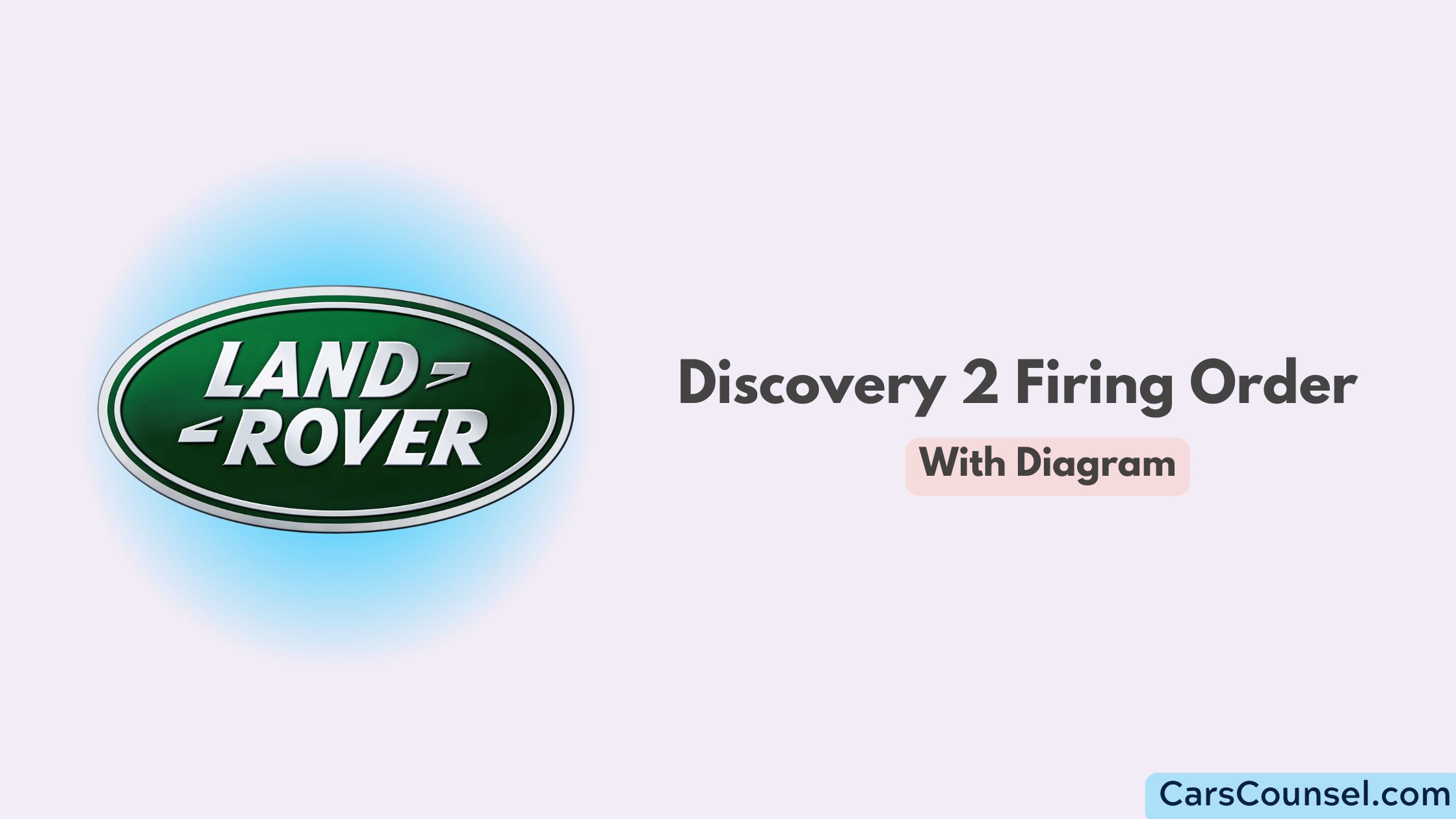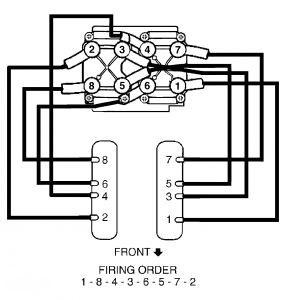The Land Rover Discovery 2, an iconic SUV known for its off-road prowess, features a robust V8 engine designed for power and reliability. T
o maintain optimal performance, the engine relies on a precise firing order that ensures efficient combustion, smooth operation, and consistent power delivery.
In this article, we’ll explore the Discovery 2’s firing order, why it matters, how it works, and how to maintain it for top-notch performance.

Quick Navigation
What is a Firing Order?
The firing order refers to the specific sequence in which an engine’s cylinders ignite their air-fuel mixture during combustion. For the Discovery 2’s V8 engine, the firing order is 1-8-4-3-6-5-7-2.

This sequence ensures that the power strokes are evenly distributed across the engine’s eight cylinders, resulting in smooth operation and balanced power output.
Why the Firing Order Matters
The firing order is a critical aspect of engine functionality. Here’s why it’s so important:
- Engine Balance: The firing order ensures that power strokes are evenly spaced, reducing vibrations and improving stability.
- Power Delivery: Proper sequencing guarantees smooth and consistent torque, enhancing performance during acceleration and heavy loads.
- Efficiency: Correct ignition timing promotes complete combustion, improving fuel economy and reducing emissions.
- Durability: Balanced firing reduces wear on engine components, extending their lifespan.
- Smooth Operation: A proper firing order prevents misfires and rough idling, ensuring reliable and efficient engine performance.
An incorrect firing order can lead to noticeable issues, including engine misfires, loss of power, and increased fuel consumption.
The Discovery 2 Firing Order: 1-8-4-3-6-5-7-2
The firing order for the Discovery 2’s V8 engine, 1-8-4-3-6-5-7-2, is specifically designed for the engine’s configuration. Let’s break it down step by step:
- Cylinder 1 Fires First: The cycle begins with Cylinder 1 igniting its air-fuel mixture.
- Cylinder 8 Fires Next: Cylinder 8 follows, maintaining the rhythm of the sequence.
- Cylinder 4 Engages: Cylinder 4 ignites, continuing the balanced power strokes.
- Cylinder 3 Fires: Cylinder 3 takes its turn, contributing to consistent performance.
- Cylinder 6 Engages: Cylinder 6 fires, ensuring smooth operation.
- Cylinder 5 Fires: Cylinder 5 follows, supporting balanced engine output.
- Cylinder 7 Fires: Cylinder 7 takes its turn, maintaining the sequence.
- Cylinder 2 Completes the Cycle: Finally, Cylinder 2 fires, and the sequence repeats.
This firing order ensures smooth power delivery and keeps the engine running efficiently.
How the Firing Order Works in the Discovery 2 Engine
The Discovery 2’s V8 engine operates on a four-stroke cycle, which includes the following stages:
- Intake Stroke: The intake valve opens, and the air-fuel mixture enters the cylinder.
- Compression Stroke: The piston compresses the mixture, preparing it for ignition.
- Power Stroke: The spark plug ignites the mixture, generating an explosion that drives the piston downward to create power.
- Exhaust Stroke: The exhaust valve opens, releasing the burnt gases from the cylinder.
The firing order synchronizes these stages across all eight cylinders, ensuring continuous and balanced power output.
Key Components Supporting the Firing Order
Several critical components work together to maintain the correct firing order in the Discovery 2. These include:
- Crankshaft: Converts the pistons’ up-and-down motion into rotational energy, driving the sequence of power strokes.
- Camshaft: Times the opening and closing of the intake and exhaust valves to align with the firing order.
- Ignition Coils: Deliver electrical energy to the spark plugs, ensuring proper ignition timing.
- Spark Plugs: Ignite the air-fuel mixture in each cylinder at the precise moment.
- Engine Control Unit (ECU): Electronically manages the firing order, optimizing ignition timing and fuel delivery.
When these components work together seamlessly, the engine operates reliably and efficiently.
Symptoms of Firing Order Problems
If the firing order is disrupted, the engine may display several noticeable symptoms. Common signs of firing order issues include:
- Engine Misfires: Cylinders fail to ignite correctly, causing uneven power delivery.
- Rough Idling: The engine vibrates excessively or runs inconsistently when idle.
- Loss of Power: An incorrect firing order reduces efficiency, leading to sluggish acceleration.
- Backfiring: Faulty ignition timing may cause combustion gases to ignite in the intake or exhaust system.
- Increased Vibrations: An imbalanced firing sequence creates noticeable engine vibrations during operation.
Addressing these issues promptly is crucial to prevent further damage to the engine.
How to Verify the Firing Order
To confirm the firing order of the Discovery 2’s engine, follow these steps:
- Inspect Ignition Wires: Ensure each ignition wire is connected to the correct cylinder as per the firing order.
- Check Spark Plugs: Verify that the spark plugs are clean, functional, and properly installed.
- Use a Timing Light: A timing light can confirm that each spark plug is firing at the appropriate time.
- Consult the Service Manual: The correct wiring diagram and cylinder numbering are in the Discovery 2’s service manual.
- Listen for Irregular Sounds: Sputtering, knocking, or other unusual engine noises may indicate firing order problems.
Routine inspections help maintain the firing order and ensure smooth engine operation.
Maintaining the Firing Order
Proper maintenance is essential for preserving the firing order and ensuring the engine performs optimally. Here are some tips:
- Replace Spark Plugs as Needed: Worn or fouled spark plugs can disrupt the firing sequence and cause misfires.
- Inspect Ignition Wires and Coils: Check for signs of wear, cracks, or corrosion that may interfere with ignition.
- Clean Fuel Injectors: Dirty fuel injectors can cause uneven fuel delivery, impacting combustion timing.
- Monitor the ECU: Ensure the ECU is functioning correctly and update its software if necessary.
- Use High-Quality Fuel: Clean-burning fuel reduces carbon buildup, promoting efficient combustion.
Regular maintenance ensures reliable performance and prevents issues related to the firing order.
Can You Modify the Firing Order?
The firing order for the Discovery 2, 1-8-4-3-6-5-7-2, is specifically designed for the V8 engine’s configuration. Modifying this sequence is not recommended because:
- Imbalance Issues: Altering the firing order can cause excessive vibrations and instability.
- Reduced Efficiency: An incorrect firing order disrupts combustion, leading to power loss and increased fuel consumption.
- Potential Damage: Changes to the firing order may stress engine components, resulting in long-term damage.
For performance improvements, consider tuning the ECU, optimizing the intake and exhaust systems, or enhancing fuel delivery instead of altering the firing order.
Engines with Similar Firing Orders
- 2001 Land Rover Discovery Firing Order
- 2004 Land Rover Discovery Firing Order
- 2003 Land Rover Discovery Firing Order
Conclusion
The firing order of the Discovery 2, 1-8-4-3-6-5-7-2, is a critical aspect of its engine design. This carefully sequenced ignition ensures smooth power delivery, balanced operation, and efficient combustion. Understanding the firing order and maintaining it properly is essential for preserving the vehicle’s performance and reliability.
By performing regular maintenance, addressing issues promptly, and using high-quality components, you can keep your Discovery 2 running smoothly for years to come. Whether you’re tackling off-road adventures or daily commutes, maintaining the correct firing order ensures dependable and consistent performance.

